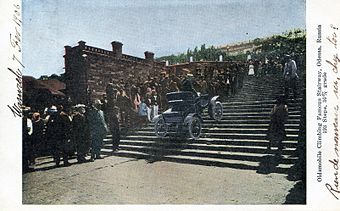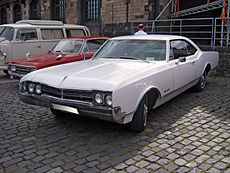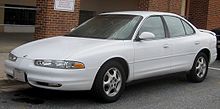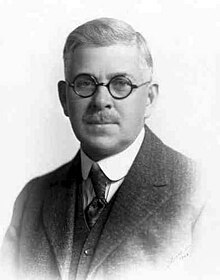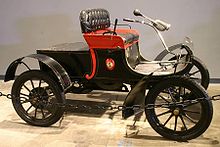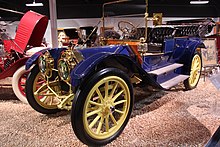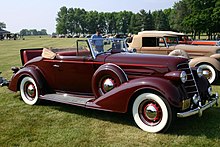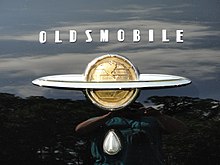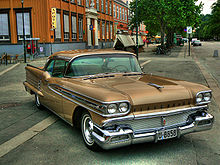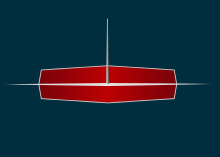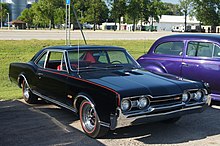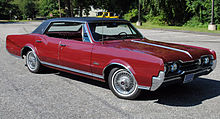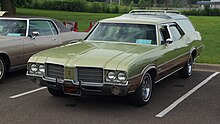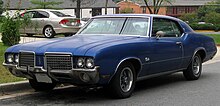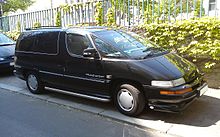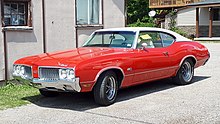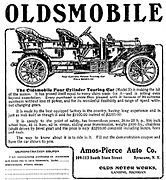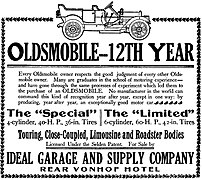| Oldsmobile | |
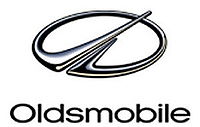 |
|
| Год основания |
21 августа 1897 |
|---|---|
| Упразднена |
2004 |
| Основатели |
Рэнсом Олдс |
| Расположение |
Лансинг, США |
| Отрасль |
Автомобилестроение |
| Материнская компания |
General Motors |
| Сайт |
www.oldsmobile.com (англ.) |
Oldsmobile — марка автомобилей, большую часть своего существования принадлежавшая корпорации General Motors. Основана Рэнсом Ели Олдсом в 1897 году и просуществовала до 2004 года. За свою 107-летнюю историю компания произвела 35,2 миллиона автомобилей, из них около 14 миллионов на своём заводе в Лансинге. До момента упразднения являлась одной из старейших автомобильных марок.
Содержание
- 1 История
- 1.1 Ранняя история
- 1.2 1930-е
- 1.3 1940-е
- 1.4 1950-е
- 1.5 1960-е
- 1.6 1970-е — 1980-е
- 1.7 1990-е
- 1.8 2000-е
- 2 Автомобили Oldsmobile
История
Ранняя история
Автомобили Oldsmobile впервые были произведены на заводе «Olds Motor Works» в Лансинге, штат Мичиган, основанном Рэнсом Олдсом в 1897 году. В 1901 году компания выпустила 425 автомобилей, став первым производителем бензиновых автомобилей большого объема. На протяжении нескольких лет «Olds Motor Works» лидировала в США по числу проданных автомобилей. В период финансовых трудностей Рэнсом Олдс оставил компанию и основал другую, REO Motor Car Company. Последние автомобили Olds были выпущены в 1907 году, после чего компания была выкуплена корпорацией General Motors в 1908 году.
В период с 1901 по 1904 годы модель Curved Dash была первым массово производимым автомобилем, собранным на первой автоматизированной сборочной линии, изобретение которой ошибочно приписывается Генри Форду. После того как Олдс продал свою компанию в 1899 году, она сменила имя на Olds Motor Works, а завод переехал в Детройт. К марту 1901 года компания имела целый модельный ряд, готовый к производству, однако из-за неосторожности рабочего на заводе случился пожар в результате которого фабрика была полностью уничтожена, с ней же погибли и все готовые прототипы. Единственным уцелевшим автомобилем стал прототип Curved Dash, который был вывезен двумя заводскими рабочими после начала пожара. Был построен новый завод, на котором и началось производство Curved Dash.
Официально автомобили назывались «Olds automobiles», однако в разговорной речи именовались «Oldsmobiles». Это прозвище в основном относилось к модели Curved Dash и приобрело известность благодаря популярной в 1905 году песне «In My Merry Oldsmobile».
Модель 1910 года Limited Touring стала топовой для компании. Имевший 42-дюймовые колеса с «заводской» белой резиной, Limited являлся наиболее престижной моделью из линейки Oldsmobile. Limited продавали по цене $4,600, что соответствовало стоимости большого дома с тремя спальнями. За свои деньги покупатели получали салон, отделанный козлиной кожей, 60-сильную рядную «шестерку» объемом 11,58л, стартер Bosch Magneto, подножки и пятиместный салон. В качестве опций можно было также заказать спидометр, часы и цельное лобовое стекло. Версия лимузин стоила $5,800. За три года было продано всего около 725 автомобилей Limited, однако больше всего эта модель запомнилась тем, что выиграла гонку у знаменитого поезда того времени «20th Century Limited».
1930-е
В период с 30-х по 40-е годы использовались двухциферные обозначения для названий автомобилей Oldsmobile. Первоначально предполагалось, что первая цифра будет обозначать размер кузова, а вторая — число цилиндров. Кузова были представлены размерами 6, 7, 8 и 9, а двигатели — 6- и 8-цилиндровые. Таким образом, автомобили Oldsmobile могли иметь название с Oldsmobile 66 до Oldsmobile 98.
В 1937 году Oldsmobile стала первой компанией, представившей четырехскоростную полуавтоматическую коробку передач, имевшую название Automatic Safety Transmission несмотря на то, что этот механизм на самом деле был произведен компанией Buick (которая представила его только в 1938 году). Автомобили с такой трансмиссией имели обычную педаль сцепления, которую водитель нажимал перед тем как выбрать положение Low или High. В положении Low работали 1-я и 2-я передачи, в положении High — 1-я, 3-я и 4-я передачи.
1940-е
В 1940 году Oldsmobile стала первым автопроизводителем, который предлагал полностью автоматическую коробку передач «Hydramatic», имевшую 4 скорости.
Последний довоенный Oldsmobile покинул конвейер 5 февраля 1942-го года. Во время Второй мировой войны производство Oldsmobile перевели на военные нужды, и на заводе собирались крупнокалиберные пушки и снаряды для них. Производство автомобилей возобновилось 15 октября 1945 года с обновленной моделью 1942 года, которая производилась до 1946 года.
Oldsmobile стал первопроходцем в 1949 году, когда представил свой первый мотор V8, названный «Rocket». Компоновка двигателя значительно отличалась от существующих, так как в то время превалировали рядные «восьмерки». Двигатель выдавал значительно больше мощности нежели его современники, и поэтому был невероятно популярен среди хот-роддеров и гонщиков. Конструкция этого двигателя, с небольшими изменениями, сохранялась до середины 60-х, когда появился новый V8 от Oldsmobile.
1950-е
Oldsmobile Dynamic 88 2T Coupé
Oldsmobile вошёл в 50-е под знаком двигателей «Rocket» и машин, агрегатированных им. «Rocket V8» был лидером по мощности, и машины оснащённые им считались самыми быстрыми. На протяжении всех пятидесятых машины Oldsmobile выпускали стилистически соответствующими теме «Rocket», имели большую радиаторную решетку и сдвоенные задние фонари, своей формой обязанные также стилю «Rocket». Oldsmobile первым из концерна General Motors выпустили хардтоп в 1949 году, также Oldsmobile — одно из первых отделений GM наряду с Buick и Cadillac, которые начали выпускать автомобили с панорамным ветровым стеклом, которое стало общей чертой для всех американских автомобилей, выпускавшихся с 1953 по 1964 годы.
В 1950-х номенклатура названий автомобилей модельнго ряда Oldsmobile изменилась. К двухциферному коду стали добавлять слова, обозначающие тип кузова. Так, Oldsmobile 88 получил названия Oldsmobile Dynamic 88 и Oldsmobile Super 88 для базовой и люксовой версий соответственно. В названиях хардтопов появилось слово «Holiday», универсалы маркировались как «Fiesta». Когда в 1999 году закрылось производство 88 модели, это стало вторым по длительности использования наименованием автомобиля после Chrysler New Yorker.
Дизайн GM потерял статус «законодателя мод» в 1957 году, когда Chrysler представил дизайн «Forward Look» за авторством Вирджила Экснера. Основной проблемой для Oldsmobile и Buick стала дизайнерская ошибка GM под названием «Strato Roof». И Oldsmobile, и Buick производили модели имевшие каркасные стекла заднего вида, однако модели с большими изогнутыми задними фонарями выпускались все последующее десятилетие. Потребители критиковали крышу и неудачние фонари, заставляя GM изменить дизайн некоторых выпускаемых концерном моделей.
Единственным неудачным годом в 50-х для Oldsmobile стал 1958 год. Страна начинала ощущать экономический спад после войны, и продажи автомобилей начали падать. Oldsmobile, Buick и Cadillac получили от GM сильно обновленные брендовые стили. Oldsmobile планировал выпускать слегка переработанные в плане дизайна автомобили, имеющие общие черты с предшественниками, однако вместо этого возник огромный, чрезмерно украшенный хромированными деталями автомобиль.
В дополнение, все машины Oldsmobile 1958 года получили глубоко переработанный дизайн передка, включающий в себя четыре головные фары. По бокам проходили хромированные полоски, начинающиеся от края фар, две полоски на обычных 88-х, 3 полоски на Super 88 и 3 полоски (тонкие сверху и снизу и широкая посередине), которые кончались точкой в середине кузова на 98-х. Низ заднего бампера имел широкую выштамповку в виде полукруга. Задние фары были обрамлены массивными хромированными деталями. Дизайнер-консультант компании Ford Алекс Тремулис (Alex Tremulis, автор дизайна Tucker Sedan 1948 года) высмеял Oldsmobile 1958 года за четыре горизонтальные полосы на заднем бампере, нарисовав карикатуру с музыкальными нотами на этих полосках.
Другой детройтский дизайнер, работавший на компанию Ford, купил подержанный Oldsmobile 1958 года в начале 60-х, переставил буквы над решеткой радиатора таким образом чтобы вместо «OLDSMOBILE» получилось «SLOBMODEL» («неряшливая модель») и в таком виде ездил каждый день на работу, чтобы напоминать себе и своим коллегам, что означает «плохой» дизайн автомобиля в их бизнесе.
1960-е
В 60-х позиция Oldsmobile в иерархии GM (между Pontiac и Buick) улучшилась. Значительные достижения, включающие в себя первый турбированный двигатель в 1962 году («Turbo Jetfire»), первый современный переднеприводный автомобиль, произведенный в США (Oldsmobile Tornado 1966-го года), примечательный своей панорамной крышей универсал Vista Cruiser — все это позволило компании увеличить свой авторитет.
1970-е — 1980-е
В течение 70-80-х продажи Oldsmobile довольно сильно выросли (абсолютный максимум, зафиксированный в 1985 году — 1 066 122 автомобиля) из-за модного современного дизайна, положительных отзывов в прессе и высокого качества и надежности двигателя «Rocket V8». В 1976 году автомобиль Oldsmobile Cutlass стал самым продаваемым автомобилем в Северной Америке. К этому времени Oldsmobile сместил с третьей позиции наиболее продаваемых марок Pontiac и Plymouth и прочно занял эту позицию вслед за Chevrolet и Ford. В начале 80-х продажи достигали 1 миллиона, чего до этого удавалось добиться только Chevrolet и Ford. Растущая популярность автомобилей Oldsmobile вызвала серьёзные проблемы в конце 70-х. К тому времени все подразделения GM производили собственные двигатели V8, а в 1977 году Oldsmobile, Chevrolet, Pontiac и Buick разработали уникальные 5,7-литровые двигатели на замену V8.
В течение 1977 года производство Oldsmobile V8 не могло полностью обеспечить спрос, и поэтому большинство Oldsmobile Delta 88 снабжались 5,7-литровыми двигателями Chevrolet. Широко обсуждалось, велика ли разница в качестве и производительности этих двух двигателей, но одно было известно наверняка — эти два двигателя были совершенно разные по конструкции. Многие лояльные по отношению к Oldsmobile покупатели были нацелены на покупку автомобиля именно с двигателем «Rocket V8», но обнаруживали, что на их машинах установлены совершенно другие двигатели только тогда, когда оказывалось, что купленные ими запчасти не подходят к двигателям Chevrolet. Этот скандал стал настоящим кошмаром для GM.
После этого скандала во всех рекламных буклетах указывалось что «автомобили Oldsmobile оборудованы двигателями, произведенными различными подразделениями GM», и все подразделения GM последовали этому примеру и также разместили подобную информацию в своих буклетах и брошюрах. В дополнение к этому руководство GM решило перестать ассоциировать двигатели с конкретными производителями, и по сегодняшний день все двигатели GM произведены компанией «GM Powertrain» (GMPT).
1990-е
После головокружительного успеха начала 80-х положение Oldsmobile резко изменилось, и к 1990 году марка потеряла свои позиции на рынке, вернувшись в свою нишу между Pontiac и Buick. Вместо собственных автомобилей Oldsmobile стал производить ребрендовые модели других подразделений GM, а право заниматься собственными разработками перешло к Chevrolet и Pontiac. GM продолжал использовать Oldsmobile время от времени для демонстрации новых футуристических дизайнов и в качестве «подопытного кролика» для обкатки новых технологий, результатом чего стало появление Oldsmobile Toronado, который был оборудован бортовым компьютером с календарем, ежедневником и климат-контролем. В 1995 году Oldsmobile представил модель Aurora, которая должна была показать направление деятельности компании в середине 90-х. Представление этой модели послужило для GM поводом сделать Oldsmobile основным импортером концерна. В связи с этим изменился логотип Oldsmobile на более соответствующий фирменной «ракетной» теме. Постепенно практически все модели Oldsmobile были сняты с производства. Все они были заменены более современными моделями, вдохновленными Aurora.
2000-е
Несмотря на успехи Oldsmobile в середине 90-х, снижение спроса на автомобили марки дали GM повод объявить в 2000 году о постепенном упразднении бренда Oldsmobile. Это объявление было сделано спустя два дня после того как Oldsmobile представила свою последнюю модель — джип Bravada, который по иронии стал хитом продаж подразделения.
Последние выпущенные 500 автомобилей моделей Alero, Aurora, Bravada, Silhoette и Intrigue получили особые шильдики, на которых было написано «Final 500». Все 500 автомобилей были окрашены в особый цвет — Dark Cherry Metallic. «Авроры» и «Интриги» также комплектовались специальными брошюрами «Final 500».
29 апреля 2004 года — последний день производства марки Oldsmobile. Последней выпущенной машиной стал 4-дверный седан Alero GLS, на котором были росписи всех сотрудников сборочной линии.
Автомобили Oldsmobile
Oldsmobile Intrigue
- Oldsmobile Curved Dash (1901—1907)
- Oldsmobile Limited Touring
- Oldsmobile 40
- Oldsmobile 53
- Oldsmobile 66 (1940s)
- Oldsmobile 88 (1949—1999)
- Oldsmobile 98 (1941—1996)
- Oldsmobile Series 60 (1939—1948)
- Oldsmobile Series 70 (1946—1950)
- Oldsmobile Series 90 (1941—1996)
- Oldsmobile 442 (1968—1971)
- Oldsmobile Cutlass (1964—1999)
- Oldsmobile Cutlass Supreme (1970—1997)
- Oldsmobile Cutlass Salon
- Oldsmobile Cutlass Calais (1985—1991)
- Oldsmobile Cutlass Ciera (1982—1996)
- Oldsmobile Custom Cruiser (1971—1992)
- Oldsmobile Vista Cruiser (1964—1977)
- Oldsmobile F-85 (1961—1963)
- Oldsmobile Toronado (1966—1992)
- Oldsmobile Starfire (1975—1980)
- Oldsmobile Firenza (1982—1988)
- Oldsmobile Aerotech(1987—1992)
- Oldsmobile Achieva (1992—1998)
- Oldsmobile Alero (1999—2004)
- Oldsmobile Aurora (1995—2003)
- Oldsmobile Bravada (1991—2004)
- Oldsmobile Intrigue (1998—2002)
- Oldsmobile Silhouette (1990—2004)
| Oldsmobile на Викискладе? |
Oldsmobile был брендом американского автомобильного производства на протяжении большей части своего существования General Motors. Был основан Рэнсом Е. Олдсом (Ransom E. Olds) в 1897 году. В свою 107-летнюю историю, он произвел 35200 тысяч автомобилей.
Производитель: Oldsmobile Division (дочернее предприятие GM)
Производство: 1961-1981
Класс: Compact/Mid-size
Тип кузова: 2-дверный купе / 2-дверный кабриолет / 2-4-дверный седан / 4-5-дверный универсал
Дизайнеры: Ирвинг Рыбицки (Irving Rybicki)
Двигатели:
Карбюраторный, дизельный 4-х тактный
215-й (3,5 л) V8 116 кВт, 155 л.с. 1961-63
225-й (3,7 л) V6 115 кВт; 155 л.с. 1964-67
250-й (4,1 л) I6 115 кВт; 155 л.с. 1964-77
330-й (5,4 л) V8 до 228 кВт; 310 л.с. 1964-67
400-й (6,6 л) V8 254 кВт; 345 л.с. 1964-72
350-й (5,7 л) V8 до 228 кВт; 310 л.с. 1968-77
455-й (7,5 л) V8 200 кВт; 270 л.с. 1968-77
231-й (3,8 л) V8 82 кВт; 110 л.с. 1973-88
260-й (4,3 л) V8 00 кВт; 00 л.с. 1973-88
403-й (6,6 л) V8 00 кВт; 00 л.с. 1973-77
260-й Diesel (4,3 л) V8 67 кВт; 90 л.с. 1978-88
301-й Pontiac (4,9 л) V8 до 157 кВт; 210 л.с. 1978-88
305-й (5,0 л) V8 118 кВт; 160 л.с. 1978-88
Коробка передач:
3-х ступенчатая механическая
4-х ступенчатая механическая
5-х ступенчатая механическая
2-х ступенчатая автоматическая
3-х ступенчатая автоматическая
Привод:
Классический, задний
Об автомобиле
Oldsmobile Cutlass — это линейка автомобилей, произведенных компанией Oldsmobile коорпорации General Motors в период с 1961 по 1981 года. Cutlass проектировали как компактный автомобиль, но популярность получил уже как промежуточный.
Первый «Катласс» выпустили в качестве эксперимента в 1954 году как спортивное купе с 2800мм колесной базой и крышей в стиле фастбэк. Его платформа была очень похожа на F-85, которая не была введена еще как минимум семь лет.
1961–1963
General Motors приступил к разработке своего первого из компактных автомобилей в 1956 году, с Chevrolet Corvair. В следующем году очередь пала на Buick, Oldsmobile и Pontiac. Они будут иметь одни и те же типы кузова и двигатели. Дизайнер Oldsmobile Ирвинг Рыбицки (Irving Rybicki) начал работу над моделью Олдс в 1957 году. И, наконец, Cutlass поступил в продажу в 1960 году как модель 1961.
Oldsmobile называют еще F-85, так как по прежнему используется общая платформа 2845мм. Это был маленький и недорогой автомобиль с пружинной, поперечно-рычажной подвеской. Стандартным двигателем был небольшой V8, алюминиевый 3,5 литровый блок с двойным карбюратором, выдававший 155 л/с (116 кВт). Коробка передач была первоначально трехступенчатой «механикой», но вскоре ее сменил трех ступенчатый вариатор Roto Hydramatic. F-85 имел барабанные тормоза на 9,5 дюймов (240 мм) диаметра. Общая длина 188,2 дюйма (4780 мм), а снаряженная масса составляла около 1300 кг.
Начиная с первого поколения F-85 была предложена как двухдверный седан, четырехдверный седан с базовой или Deluxe отделкой и как четырехдверный универсал, в том числе и комфорт. Первоначальные продажи несколько удручали, но с выходом в мае 1961 года спорт купе, с V8 блоком на 185 л/с (133 кВт) ситуация намного улучшилась.
Журнал «Car Life magazine» испытывал Cutlass со стандартным двигателем и автоматической коробкой передач. Результаты следующие: разгон 0-100 км/ч = 14,5 с; максимальная скорость = 160 км/ч. Они неплохо отозвались о конструкции в целом, но слишком мягкая подвеска не способствовала «рваной» езде.
В 1962 году был добавлен кузов кабриолет, очень популярный в те времена. Появляется турбированный двигатель для седана Cutlass Jetfire 215-й V8 мощностью 215 л/с (160 кВт). Машину оборудывают ковшеобразными сидениями и вакуумным усилителем тормозов.
Jetfire был подвергнут критике, все из за все той же мягкой подвески и отсутствия тахометра. Cutlass Jetfire разгонялся от 0-100 км/ч за 9,2 с, а максимальная скорость была уже 176 км/ч. Высокая стоимость и ненадежная турбина ограничили продажи в районе 3765 шт.
В 1963 году завод провел лишь скромный рестайлинг, увеличив общую длину до 192,2 дюймов (4880 мм).
1964–1967
Неутешительный опыт продаж компактных F-85 сподвиг GM на увеличение модели до промежуточного класса.
Новый F-85 теперь имел колесную базу в 2900 мм, а общая длина возросла до 5200 мм, и прибавил в весе на 140 кг. Алюминиевый блок заменили чугунным V8 330-м (5,4 л).
За 1965 год еще раз претерпела изменений конструкция кузова — колесная база стала уже 5190 мм. Появляются большие двигатели, до 6,9 л включительно. Продажи бьют все рекорды — за год продано более 187000 шт, американцы оценили восьмицилиндровый Big block!
Главной новостью в 1967 году несомненно было внедрение дисковых тормозов и трехступенчатой коробки Turbo-Hydramatic в дополнение к двухскоростной Jetaway.
1968–1972
F-85 в очередной раз модернизируют. Колесная база остановилась для двухведерных Oldsmobile на отметке 2800 мм, а у четырехдверных составила 2900 мм. По словам разработчика это способствует обретению индивидуального стиля.
Двигатели предлагались аналогично прошлому году, хотя вариант с V8 был расширен еще одним 350-м (5,7 л) с двойным карбюратором и двухскоростным вариатором. Выпуск трехскоростной коробки передач Turbo Hydra-matic был прекращен.
В 1969 модели F-85/Cutlass получают незначительные изменения отделки интерьера и экстерьера. Меняются задние фонари — теперь они вертикальные. Замок зажигания из-за федерального закона «о безопасности движения» переезжает из приборной панели на рулевую рейку. Появляется незамысловатая блокировка руля.
350-й двигатель (5,7 л) форсируют с завода с помощью четырехкамерного карбюратора до 310 л/с (230 кВт) без каких-либо серьезных переделок, который теперь стал называться «350 Rocket V8 Ultra High Compression».
В 1971 году Cutlass получает новый капот, решетку радиатора, фары, бампера и задние фонари. так же предлагались четыре новые расцветки, в том числе «золотой».
1973–1977
Линии кузова в Cutlass были переработаны с изменением платформы нового образца «Colonnade». На ней строились Cutlass, Cutlass «S», Cutlass Supreme, Cutlass Salon, Vista Cruiser универсал, и Oldsmobile 442, который предлагали в качестве опции.
В 1973 году «Катласс» включал обновленную усиленную подвеску, радиальные шины и ковшеобразные сиденья. Стандартным стал 350-й двигатель с 180 л/с. Самым же мощным предлагался V8 455-й (L77) с 270 л/с.
В 1975 году Oldsmobile добавил два небольших двигателя для привлечения покупателей, в период после энергетического кризиса 1973-74. Им стали шестицилиндровый Chevrolet-250 и восьмицилиндровый 260-й, за основу которого был взят все тот же Олдс 350. В качестве опции имелся и 455-й блок мощностью 190 л/с (140 кВт).
Oldsmobile Cutlass становится самым продаваемым автомобилем Америки в 1976 году, и будет держать этот титул почти до 80-х годов.
Прямоугольные фары стали товарным знаком Olds того времени. Задние фонари были так де пересмотрены, номерной знак и лючок топливного бака перенесены выше бампера.
В 1977 году изменяют приборную панель: бардачок переезжает в низ, а часы сдвигаются вправо.
1978–1988
В 1978 году колесная база сокращена до 2743 мм, вместе с ней меняется и вес до 1500 кг. Набор двигателей впечатлял, он предлагался почти из всей корпорации GM: Buick 231 V6, Oldsmobile 260 V8, Pontiac 301 V8 и Chevrolet 305 со сдвоенным или одним четырехкамерным карбюратором.
В 1979 году на Cutlass появляется дизельный двигатель Oldsmobile 260 Diesel.
В 1980-м снимают с производства четырехдверные версии из-за посредственных продаж.
Кузов фастбэк прекратил свое существование в 1981-м. «Верхние» модели «Катласса» получают рестайлинг, который включал в себя более аэродинамический нос и сглаженные линии кузова. Седаны получают четыре фары и новую решетку радиатора, а опция 442 больше не предлагалась.
Oldsmobile был брендом американского автомобильного производства на протяжении большей части своего существования General Motors. Был основан Рэнсом Е. Олдсом (Ransom E. Olds) в 1897 году. В свою 107-летнюю историю, он произвел 35200 тысяч автомобилей.
Производитель: Oldsmobile Division (дочернее предприятие GM)
Производство: 1966–1992
Класс: Personal luxury car
Тип кузова: 2-дверный купе / 2-дверный кабриолет
Дизайнеры: John Beltz
Двигатели:
Карбюраторный, инжекторный 4-х тактный
425-й (7,0 л) V8 283 кВт, 385 л.с. 1966-70
455-й (7,5 л) V8 300 кВт, 400 л.с. 1968-78
403-й (6,6 л) V8 138 кВт, 185 л.с. 1977-78
252-й (4,1 л) V6 93 кВт; 125 л.с. 1979-85
307-й (5,1 л) V8 130 кВт; 180 л.с. 1985-87
350-й (5,7 л) V8 до 174 кВт; до 200 л.с. 1979-85
350-й Diesel (5,7 л) V8 до 93 кВт; до 125 л.с. 1979-85
231-й (3,8 л) V6 до 123 кВт; до 165 л.с. 1986-92
Коробка передач:
3-х ступенчатая автоматическая
4-х ступенчатая автоматическая (в поздних версиях)
Привод:
Передний
Об автомобиле
Торнадо был двухдверный купе, производится отделением Oldsmobile в период с 1966 по 1992 год.
Имя «Торнадо» не несло смысловой нагрузки, и было первоначально озвучено для автосалона Chevrolet в 1963 году. Задуманный как полноразмерный автомобиль повышенной комфортности и непосредственно конкурирующий с Ford Thunderbird, Торнадо оставил в истории значимый след, как первый переднеприводный автомобиль производства США после Cord 812 Automobile 1937 года.
По структуре, Торнадо относится к заднеприводным Buick Riviera и Cadillac Eldorado образца 1966 года, хотя каждый из них имел неповторимый стиль. Торнадо строился на E-платформе, вместе с Ривьерой и Эльдорадо, и был неизменным на протяжении большей части своей 28-летней истории.
1966–1970
Оригинальный дизайн Toronado впервые бал представлен Дэвидом Нортом (David North) в 1962 году. Этот ранний проект имел название «Пламенная Красная Машина», был концепт-каром и для производства никогда не предназначался. Спустя недели, дизайн для этого автомобиля был согласован с Oldsmobile. Для экономии была взята за основу E-платформа, известная еще с Buick Riviera, но которая была больших размеров, нежели планированная.
Олдсмобил начал разрабатывать привод на передние колеса с 1958 года по проекту инженера Джона Белтца (John Beltz), который разрабатывал модель 442. Целых семь лет и миллионы миль жесточайших испытаний понадобилось на то, чтобы руководство одобрило автомобиль в плане прочности и надежности.
Первый торнадо вышел с 3-ступенчатым автоматом Turbo-Hydramatic, а двигатель оснащался четырехкамерным карбюратором Rochester. Firestone разработали для новой модели специальные шины TFD (Toronado-Front-Drive) размером 8,85 «х 15″, которые имели более жесткий корд, чем обычные и отличались уникальной белой полосой.
Двигатель был выбран обычный Olds, хоть и увеличенной производительности V8 425-й (7,0 л) мощностью 385 л/с (287 кВт) и имеющий 644 Нм крутящего момента. Выпускной коллектор был уникален по конструкции, чтобы обеспечить лучший отток газов.
Для экономии, передняя торсионная подвеска была заменена на более простую — двойную рычажную. Задняя же часть оставалась рессорной, но с двумя амортизаторами — вертикальным и горизонтальным.
Тормоза оставались барабанными 11» (297 мм), которые, как правило, считались слабым звеном новоиспеченной модели. Будучи довольно тяжелым автомобилем (2300 кг), после нескольких остановок, тормоза перегревались, что приводило к значительному увеличению тормозного пути. Все изменилось в 1967 — в качестве опции устанавливались передние вентилируемые диски.
А в последнем, перед рестайлингом модели 1970 году, стационарные передние фары сменяются всплывающими.
Оригинальные дорожные испытания:
Разгон 0-100 км — 7,5 сек.
Драг-рейсинг на 1/4 мили — 16,4 сек. при 150 км/ч
Максимальная скорость — 217 км/ч
Специальная опция W-34 («GT») была доступна для Торнадо в 1968-70 годах. Она включала сдвоенный выхлоп, систему забора холодного воздуха, более производительный распредвал и новую настройку для коробки передач для лучшего разгона. При такой настройке мощность заметно выросла и достигла 400 л/с (300 кВт).
Оригинальные дорожные испытания:
Разгон 0-100 км — 7,5 сек.
Драг-рейсинг на 1/4 мили — 15,7 сек. при 144,5 км/ч
1971–1978
Второе поколение радикально отличалось от первого. Жесткая спортивная подвеска сменилась на мягкую пружинную. Toronado стал больше похожим на роскошный Cadillac Eldorado, чем на Buick Riviera. Новый взгляд на модель привлек новых состоятельных покупателей.
Кузов Toronado 1971 года стал крупнее, чем на предыдущих моделях, как и колесная база с 119 до 122 дюймов (3100 мм).
455-й двигатель (7,5 л) был перенесен с предыдущей модели и стал базироваться с 1972 года как стандартный. Теперь, после введения более жестких норм по выбросам он был оценен в 350 л/с (против 375 л/с в 1970 году), а степень сжатия упала с 10,5 до 8,5.
В период с 1974 по 1976 года Oldsmobile Toronado стал частью первых экспериментов по введению в производство боковых подушек безопасности.
На протяжении всего второго поколения внутренняя обивка салона видоизменялась каждый год. Салон предлагался как в кожаном варианте, так и более демократичном, тканевом. Задние сидения складывались в пропорции 60/40 и имели в стандартном исполнении подлокотник.
Как и подобает роскошному автомобилю, в стандартную комплектацию Торнадо уже включался усилитель руля, усилитель тормозов, передние дисковые тормоза, электронные часы на панели, ковры и колпаки. Практически все машины оснащались дополнительно кондиционером, AM/FM стерео, мягкой виниловой крышей. круиз-контролем, электрическими стеклоподъемниками, телескопическим рулем, центральным замком и шестью динамиками. Позже, начиная с 1975 года электростеклоподъемники стали входить в стандартную комплектацию.
В 1977 455-й (7,5 л) блок заменили на более экономичный 403-й (6,6 л).
1979–1985
Третье поколение дебютировало в 1978 году. Автомобиль «потерял» в весе почти 450 кг. и более 510 мм. в длину, а колесная база сократилась до 2900 мм.
Двигатель тоже претерпел не лучших изменений: стал сначала 307-м (5,0 л), а с 1981 года и вовсе 252-м (4,1 л) и уже шестицилиндровым. На выбор, конечно, предлагался большой и экономичный V8 350-й (5,7 л) дизельный блок, но он вскоре стал не популярен из-за высокой стоимости ремонта.
Трехскоростная автоматическая коробка передач Turbo Hydra-Matic была стандартной комплектацией до 1981 года, позже ее заменила четырехступенчатая кпп.
1986–1992
Четвертое, как оказалось последнее поколение Toronado просуществовало на рынке шесть лет. За это время автомобиль претерпел еще больших изменений в пользу уменьшения размеров.
Двигатель V8 не предлагался. Теперь доступен лишь легкий и надежный V6 231-й (3,8 л) с впрыском топлива.
Внутри — новая цифровая приборная панель и, опционально, система оповещения голосом все-еще напоминали атрибуты былой роскоши.
Экономические просчеты с повышениями цен на топливо потерпели полное фиаско, и в 1985 году галлон бензина стоил уже меньше 1$, а покупателей все больше стали интересовать более мощные и престижные автомобили, такие как Lincoln Town Car и Chrysler’s. Продажи Торнадо резко упали, и, забегая вперед, никогда уже не восстановятся.
В 1987 году Oldsmobile предпринимает попытку поднять продажи Tornado за счет былой спортивности. Опция Trofeo имела спортивные ковшеобразные сидения, сдвоенный выхлоп, кожаный салон, более агрессивный дизайн кузова и жесткую подвеску.
В 1989 году впервые был продемонстрирован на модели штатный бортовой компьютер, громкая связь, ABS и новый руль, с управлением радио и климат-контроля.
Из-за экономических просчетов доля продаж падала, автомобиль потерял «изюминку», стал уже и не спортивным и не роскошным, никаким. Руководство Олдсмобайл поздно поняли это, но сделать уже без больших затрат было уже невозможно. Последний Торнадо вышел с конвейера 28 мая 1992 года.
Oldsmobile был брендом американского автомобильного производства на протяжении большей части своего существования General Motors. Был основан Рэнсом Е. Олдсом (Ransom E. Olds) в 1897 году. В свою 107-летнюю историю, он произвел 35200 тысяч автомобилей.
Производитель: Oldsmobile Division (дочернее предприятие GM)
Производство: 1964-1980
Класс: Muscle Car
Тип кузова: 2-дверный купе / 2-дверный кабриолет / 5-дверный хэтчбек
Дизайнеры: John Beltz
Двигатели:
Карбюраторный, 4-х тактный
330-й (5,4 л) V8 231 кВт, 310 л.с. 1964-67
400-й (6,6 л) V8 257 кВт; 345 л.с. 1964-72
455-й (7,5 л) V8 до 200 кВт; до 270 л.с. 1968-77
350-й (5,7 л) V8 до 174 кВт; до 200 л.с. 1968-77
231-й (3,8 л) V6 130 кВт; 170 л.с. 1973-80
403-й (6,6 л) V8 136 кВт; 185 л.с. 1973-77
250-й (4,1 л) I6 130 кВт; 180 л.с. 1973-77
260-й (4,3 л) V8 78 кВт; 105 л.с. 1973-80
305-й (5,0 л) V8 186 кВт; 250 л.с. 1978-80
307-й (5,1 л) V8 130 кВт; 180 л.с. 1985-87
Коробка передач:
4-х ступенчатая механическая
5-х ступенчатая механическая (в поздних версиях)
3-х ступенчатая автоматическая
3-х ступенчатая автоматическая Turbo Hydramatic
2-х ступенчатая автоматическая (спец Jet-Away)
5-х ступенчатая автоматическая (в поздних версиях)
Привод:
Классический, задний
Об автомобиле
Oldsmobile 442 — это масл-кар, производимый путем разделения Oldsmobile от General Motors. Первоначально этот автомобиль был в качестве опции пакета для моделей F-85 и Cutlass, продаваемых в США с 1964 года. Он стал отдельной моделью с 1968 по 1971, затем снова вернулся как опция до середины 70-х годов. Oldsmobile возродил имя в 1980 в качестве опции для Cutlass.
1964-1967
В 1964 модель 442 родилась из-за конкуренции между отделов Pontiac и Oldsmobile. Она началась как поспешный ответ на Pontiac GTO. Он был создан инженером — энтузиастам из Oldsmobile Джоном Белцом (John Beltz), а помогали ему в этом Дейл Смит (Dale Smith) и главный инженер Боб Доршимер (Bob Dorshimer).
Пакет получил свое название 4-4-2 на основе сочетаний: 4-х камерный карбюратор, 4-х ступенчатая механическая коробка передач и 2-й глушитель. Его продавали по цене 285$ и был доступен на любой модели F-85 или Cutlass, кроме универсала.
Испытания первого Oldsmobile 442 были следующими: при весе в 1560 кг, машина разгонялась до 100 км/ч за 7,5 с, 1/4 мили преодолевала за 15,5 с при 140 км/ч, а максимальная скорость установилась на отметке в 186 км/ч.
В общей сложности было продано 2999 штук.
В 1965 году стал стандартом 400-й двигатель (6,6 л) с четырехкамерным карбюратором модели Rochester 4-Jet, при этом мощность возросла до 345 л/с. Кроме привычной 4-х ступенчатой механики, стала доступна в качестве альтернативы 2-х ступенчатый вариатор.
Из визуальных украшений были хромированные решетка радиатора, полосы по кузову и двойной глушитель.
Испытания F85 442 (1965) с 4-х ступенчатой МКПП получил 1/4 мили за 13,7 с при 165 км/ч, а с 2-х ступенчатым вариатором чуть скромнее — 1/4 мили за 15,5 с при 143 км/ч, с до 100 км/ч за 7,8 с.
В этом году было продано 25003 единиц.
В 1966 году главной новостью было введение двигателей L69 со сдвоенным карбюратором Rochester 2GC мощностью 360 л/с и редкого W30,а стандартный двигатель L78 был оценен в 350 л/с с 4-х камерной карбюраторной системой питания.
Двигатель W30 оснастили системой индуцирования прохладного воздуха в карбюратор, так что аккумулятор пришлось перекладывать в багажник, под капотом не оставалось больше места из-за воздушных шлангов.
Испытания L69 442 (1966) с 4-х ступенчатой МКПП: разгон от 0-100 км/ч за 6,3 с, 1/4 мили преодолевалась за 14,8 с при 156 км/ч.
В 1967 году привычный 2-х скоростной переключатель Pitch Jetaway (который ставился на Pontiac GTO, Chevrolet Chevelle SS396, и Buick GS400) заменили на 3-х скоростной Turbo-Hydramatic. Так же нововведением стали передние дисковые тормоза.
Испытания W30 442 (1967) с 4-х скоростной МКПП: 1/4 мили за 14,1 с. а разгон от 0-100 за 6,5 с.
Производство автомобилей возросло до отметки 24833 шт.
1968–1972
В этот период Oldsmobile 442 являлся уже отдельной моделью. За год было продано 33000 моделей. Максимальный крутящийся момент двигателя изменили на 3000-3200 об/мин, в отличие от ранних 3600-4000 об/мин пик, в основном из-за меньшей камеры сгорания.
Испытания были следующими: 1/4 мили за 15,1 при 148 км/ч, от 0-100 км/ч за 7,0 с, а максимальная скорость составила 185 км/ч.
В 1968 Oldsmobile совместно с партнером Hurst Performance создают модель Hurst/Olds (459 Holiday Coupes/56 Sport Coupes). Все автомобили красились в «торнадо» с чередованием черных и белых полос по кузову и вставками из орехового дерева в салоне. Модель получила 445-й двигатель W45 с 390 л/с и задние дисковые тормоза.
Испытания Hurst/Olds (1968): разгон от 0-100 км/ч = 5,4 с, 1/4 мили за 13,9 с при 168 км/ч.
За 1969 год никаких серьезных изменений не предвиделось, однако доступной стала только АКПП. Херст / Олдс вернулся с новой, царственно золотой и белой цветовой гамме, измененным капотом и 455-ым V8 двигателем, который был немного дефорсирован до 380 л/с по отношению к 1968-у году.
Испытания Hurst/Olds (1969): разгон от 0-100 км/ч = 5,9 с, 1/4 мили за 14,0 с при 163 км/ч.
В 1970 году стала доступна опция для тех, кто стремиться получить максимум из машины — W30, которая изменяла 442-й блок до неузнаваемости: алюминиевый впускной коллектор, уникальный распредвал, головки цилиндров и карбюратор. Изменения так же коснулись капота из стекловолокна с капюшоном для лучшего забора воздуха.
В этом же году визуальные изменения коснулись решетки радиатора, прямоугольные фары и вертикальные задние фонари. Oldsmobile 442 впервые показали в фильме «Бегущий человек» со Сильвестром Сталлоне (Sylvester Stallone) в главной роли.
В 1971 году 442 вернулся с незначительными изменениями. Мощность двигателя снизилась, такова была политика GM, с целью уменьшения уровня свинца и переход на не этилированный бензин. Базовый 445-й двигатель теперь выдавал 340 л/с, а W30 с забором холодного воздуха 350 л/с.
Четверть мили производительности, как сообщает журнал Road Test составила 15,2 секунды при 159 км/ч, и разгон «до сотни» за 8,9 секунды, используя TH400 автоматическую коробку передач.
К 1972 году Oldsmobile был в упадке из-за растущих цен на бензин. Но это не помешало компании выпустить специальное издание, ставшее уже традицией — Hurst/Olds. Это были купе и кабриолет с V8 и 455 л/с моторами. Выпуск был крайне ограничен.
1973-1977
В 1973 году коснулись изменения кузов: изменилась длина дверей, зафиксированы задние окна и усилена крыша от возможного опрокидывания. От этого автомобили стали тяжелей на несколько сотен футов и массивней. Внутренняя отделка салона состояла преимущественно из винила а поворотные ковшеобразные ковши-сидения поворачивались на 90 градусов для более удобства при выходе.
1974 год снова коснулся мелких декоративных изменений кузова и салона. Усилитель руля стал уже стандартным оборудованием. Hurst был исключен из списка опций.
В 1975 году радиальные шины набирают все большую популярность. А каталитические нейтрализаторы вместе с не этилированным бензином означали конец истинного двойного выхлопа. Все большую популярность набирали 6-ти цилиндровые маломощные моторы.
1978-1980
В этот период Oldsmobile 442 выпускался ограниченным тиражом. Двигатели варьировались от базового 3.8L V6, но были предложены и V8 — 305-й (5,0 л) и 260-й (4,3 л). Интерьер, как внешний, так и внутренний, навесное оборудование, все претерпело изменений.
В 1979 году выпускается ограниченным тиражом модель Hurst/Olds, основанная на седане Cutlass Calais с 350-ым двигателем (5,7 л) V8 в сочетании с 3-х ступенчатым вариатором. Доступна только в золотом с белым или золотым с черным цветом кузова и золотой оббивкой салона. Создано не более 2000 единиц.
1985-1987
Oldsmobile 442 был возрожден в 1985 году с классическим приводом на заднюю ось. Модель модель W42 и 1984 Hurst/Olds использовали один и тот же двигатель. Рычаг переключения был установлен уже на полу в консоли, между передними сидениями, так же была обновлена подвеска и тормоза. За этот период было собрано 11481 автомобиль, который был продан моментально.
1990-1991
Снова модель восстановили, но с классическими «Muscle car» ничего общего она уже не имела. 4-х цилиндровый 16-и клапанный мотор объемом 2,3 л выдавал в купе с 5-ти ступенчатой коробке передач не более 190 л/с. Более ни сдвоенные, не тем более многокамерные карбюраторные модели не выпускались, однако автомобили по-прежнему комплектовались двойным выхлопом, наверно питая ностальгией к тем временам…
The American automobile manufacturer General Motors sold a number of vehicles under its marque Oldsmobile, which started out as an independent company in 1897 and was eventually shut down due to a lack of profitability in 2004.[1]
1900–1919[edit]
|
1920–1969[edit]
|
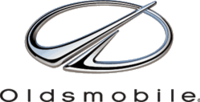 |
|

Oldsmobile building, pictured in 2008 |
|
| Formerly | Olds Motor Vehicle Company (1897–1899) Olds Motor Works (1899–1942) |
|---|---|
| Type | Private (1897–1908) Division (1908–2004) |
| Industry | Automotive |
| Founded | August 21, 1897; 125 years ago |
| Founder | Ransom E. Olds |
| Defunct | April 29, 2004; 18 years ago |
| Fate | Dissolved |
| Headquarters | Lansing, Michigan,
U.S. |
|
Key people |
Frederick Smith Angus Smith A. B. C. Hardy Irving Jacob Reuter C. L. McCuen John Beltz Charles Kettering |
| Products | Luxury and standard automobiles |
| Parent | General Motors |
Oldsmobile or formally the Oldsmobile Division of General Motors was a brand of American automobiles, produced for most of its existence by General Motors. Originally established as «Olds Motor Vehicle Company» by Ransom E. Olds in 1897, it produced over 35 million vehicles, including at least 14 million built at its Lansing, Michigan factory alone. During its time as a division of General Motors, Oldsmobile slotted into the middle of GM’s five (passenger car) divisions (above Chevrolet and Pontiac, but below Buick and Cadillac), and was noted for several groundbreaking technologies and designs.
Oldsmobile’s sales peaked at over one million annually from 1983 to 1986, but by the 1990s the division faced growing competition from premium import brands, and sales steadily declined. When it shut down in 2004, Oldsmobile was the oldest surviving American automobile marque, and one of the oldest in the world, after Mercedes-Benz, Peugeot, Renault, Fiat, Opel, Autocar and Tatra (initially Nesselsdorfer Wagenbau co.).
History[edit]
Early history[edit]
Ransom Eli Olds, the founder and namesake of Oldsmobile
Oldsmobiles were first manufactured by the Olds Motor Vehicle Co. in Lansing, Michigan, a company founded by Ransom E. Olds in 1897. In 1901 (the same year that Horace and John Dodge won a contract to produce transmissions for the Oldsmobile company), the company produced 635 cars, making it the first high-volume gasoline-powered automobile manufacturer. (Electric car manufacturers such as Columbia Electric and steam-powered car manufacturers such as Locomobile had higher volumes a few years earlier.) Oldsmobile became the top-selling car company in the United States for a few years around 1903–1904. Ransom Olds left the company in 1904 because of a dispute with sales manager Frederick Smith, who was questioning production techniques and wanted Mr. Olds to certify that each car that left the plant was free from defects. Mr. Smith then set up an experimental engineering shop without Mr. Olds’ knowledge or consent, causing Mr. Olds to leave in 1904 and formed the REO Motor Car Company.[1] This was a similar situation Henry Ford encountered when he was forced out of the company he founded, the Henry Ford Company and started the Ford Motor Company in 1903. After merging with Diamond T in 1967, Diamond Reo Trucks also lasted into the 21st century, folding in 2013.
The 1902 to 1907 Oldsmobile Model R «Curved Dash» was the first mass-produced car,[2] made from the first automotive assembly line, an invention which is often incorrectly credited to Henry Ford and the Ford Motor Company. Ford was the first to manufacture cars on a moving assembly line, while Olds used a stationary assembly line, meaning that the assembled vehicle remained in one place and workers would move from one car to the next and perform one assigned task. This differed from hand-made vehicles in the past where various workers would work on one car until it was completed and was labor- and time-intensive. After Olds merged Olds Motor Vehicle Co. with the Olds Gas Engine Works in 1899, it was renamed «Olds Motor Works» and moved to a new plant in Detroit, located at the corner of East Jefferson Avenue and MacArthur Bridge.[3] By March 1901, the company had a whole line of models ready for mass production. However, a mistake by a worker caused the factory to catch fire, and it burned to the ground, with all of the prototypes destroyed. The only car that survived the fire was a Curved Dash prototype, which was wheeled out of the factory by two workers while escaping the fire. While the factory was being rebuilt from insurance, many subcontractors were used to keep production going, to include Henry M. Leland for engines and the Dodge Brothers. Olds was a strong competitor to other independent companies Buick and Cadillac before they became divisions of General Motors between 1908 and 1909. Later after Mr. Olds left the company, Oldsmobile production was moved to Lansing.
Officially, the cars were called «Olds automobiles,» but were colloquially referred to as «Oldsmobiles.» It was this moniker, as applied especially to the Curved Dash Olds, that was popularized in the lyrics and title of the 1905 hit song «In My Merry Oldsmobile». The last Oldsmobile Curved Dash was made in 1907. General Motors purchased the company on November 12, 1908.[4] When GM assumed operations, platform sharing began with Buick products and Oldsmobile shared platforms were identified with the prefix «Series» followed by a number, while models developed by pre-GM engineers were identified with the prefix «Model» followed by a letter. Early on, Oldsmobile was a competitor to Hudson as some former engineers of Oldsmobile took positions with Hudson.
1910s[edit]
The 1910 Limited Touring Series 23 was an early, ambitious, high point for the company. Riding atop 42-inch (1067 mm) wheels, and equipped with factory «white» tires,[5] the Limited was the prestige model in Oldsmobile’s two model lineup, with the smaller Oldsmobile Autocrat Series 32 having 36-inch wheels.
The Limited retailed for US$4,600, ($133,778 in 2021 dollars [6]) an amount greater than the price of a new basic three-bedroom house. Buyers received goatskin upholstery, a 60 hp (45 kW) 707 CID (11.6 L) T-head straight-six engine, Bosch Magneto starter, running boards and room for five. Options included a speedometer, clock, and a full glass windshield. A limousine version was priced at $5,800 ($168,676 in 2021 dollars [6]). While Oldsmobile only sold 725 Limiteds in its three years of production, the car is best remembered for winning a race against the famed 20th Century Limited train, an event immortalized in the painting Setting the Pace by William Hardner Foster.
The Limited was at the time considered technologically advanced and cutting edge, if on the expensive side, but it established the division’s reputation for innovation. The Oldsmobile Series 40 was offered in 1912 and was considerably more affordable and smaller, and later the Oldsmobile Light Eight in 1916, Oldsmobile offered a Cadillac-sourced flathead V8 engine until 1923, while Buick remained with their division exclusive overhead valve straight-six engine until 1930.[7]
Beginning in 1910, bodywork was supplied by Fisher Body, a longstanding tradition that led to the company being eventually merged into GM in later years.
1920s[edit]
1928 Oldsmobile 6 (Model F-28) 4-door sedan
In 1926, the Oldsmobile Six came in five body styles, and ushered in a new GM bodystyle platform called the «GM B platform», shared with Buick products.[8]
In 1929, as part of General Motors’ companion make program, Oldsmobile introduced the higher standard Viking brand, marketed through the Oldsmobile dealer network. Viking was already discontinued at the end of the 1930 model year although an additional 353 cars were marketed as 1931 models.
1930s[edit]
1934 Oldsmobile 8 convertible coupe (Model L-34)
In the 1930s, Oldsmobile produced two body styles of automobile, the Series F (straight-6 cylinder) and the longer Series L (straight-8 cylinder).[9] In 1933 The Oldsmobile Program appeared on CBS radio for two years which was a new advertising approach to sell products and services.
In 1937, Oldsmobile was a pioneer in introducing a four-speed semi-automatic transmission called the «Automatic Safety Transmission», although this accessory was actually built by Buick, which would offer it in its own cars in 1938. This transmission features a conventional clutch pedal, which the driver presses before selecting either «low» or «high» range. In «low,» the car shifts between first and second gears. In «high,» the car shifts among first, third and fourth gears.[10]
1940s[edit]
For the 1940 model, Oldsmobile was the first auto manufacturer to offer a fully automatic transmission, called the «Hydramatic», which features four forward speeds. It has a gas pedal and a brake—no clutch pedal. The gear selector is on the steering column.
Starting in 1941 and continuing through 1999, Oldsmobile used a two-digit model designation. As originally implemented, the first digit signifies the body size while the second represents the number of cylinders. Body sizes were 6, 7, 8, and 9, and straight six- and straight eight-cylinder engines were offered. Thus, Oldsmobiles were named «66» through «98».
Until January 1, 1942, the Division was still known by the still official name of Olds Motor Works, when it was changed to the collective name the cars were known as, «Oldsmobiles». Thus, the division was officially christened the Oldsmobile Division of General Motors.
The last pre-war Oldsmobile rolled off the assembly line on February 5, 1942. During World War II, Oldsmobile produced numerous kinds of material for the war effort, including large-caliber guns and shells. Production resumed on October 15, 1945, with a warmed-over 1942 model serving as the offering for 1946.
Oldsmobile once again was a pioneer when, for the 1949 model, the Rocket engine was introduced, which used an overhead valve V8 design rather than the flathead «straight-eight» design which prevailed at the time. The overhead valve was originally exclusive to Buick as they invented the technology and offered it on all of their products. This engine produced far more power than the other engines that were popular during that era, and found favor with hot-rodders and stock car racers. The basic design, with a few minor changes, endured until Oldsmobile redesigned its V8 engines in the mid-1960s.
1950s[edit]
1953 Oldsmobile 98 convertible
1957 Oldsmobile Starfire 98 Holiday sedan with «StratoRoof» rear window
Oldsmobile entered the 1950s following a divisional image campaign centered on its ‘Rocket’ engines and the Space Race, and its cars’ appearance followed suit. Oldsmobile’s Rocket V8 engine was the leader in performance; its cars were generally considered the fastest on the market; and by the mid-1950s their styling was among the first to offer a wide, «open maw» grille, suggestive of fighter jet propulsion. From 1948 to 1957, Oldsmobile adopted a ringed-globe emblem depicting North America to stress what marketers felt was its universal appeal. Starting in 1958, the grille logo changed again to reflect the rocket image, that was used throughout the late 1950s, the make used twin jet pod-styled taillights as a nod to its «Rocket» theme. Oldsmobile was among the first of General Motors’ divisions to receive a true hardtop in 1950 called the «Holiday coupe» (Buick’s version was called the «Riviera», and Cadillac’s was called the «Coupe De Ville»), and it was also among the first divisions (along with Buick and Cadillac) to receive a wraparound windshield, a trend that eventually all American makes would share at sometime between 1953 and 1964. New for 1954 on 98 coupes and convertibles (Starfire) would be front and rear «sweep cut» fender styling, which would not show up on a Chevrolet until 1956 and not until 1957 on a Pontiac. 1953 models changed to a 12 volt electrical system that made starting easier.
In the 1950s the nomenclature changed again, and trim levels also received names that were then mated with the model numbers. This resulted in the Oldsmobile 88 emerging as base Dynamic 88 and the highline Super 88. Other full-size model names included the «Holiday» used on hardtops, and «Fiesta» used on its station wagons. When the 88 was retired in 1999 (with a Fiftieth Anniversary Edition), its length of service was the longest model name used on American cars after the Chrysler New Yorker. Mid-1955 also saw the introduction of the four-door Holiday pillarless hardtop, the industry’s first (along with Buick).
General Motors’ styling as a whole lost its frontrunner status in 1957 when Chrysler introduced Virgil Exner’s «forward look» designs. When compared side to side, Oldsmobile looked dated next to its price-point competitors DeSoto and Mercury. Compounding the problem for Oldsmobile and Buick was a styling mistake which GM called the «StratoRoof», which was reminiscent of the «greenhouse» canopy used on the Convair B-36 Peacemaker high altitude bomber. Both makes had models which contained the heavily framed rear window, but Detroit had been working with large curved backlights for almost a decade. Consumers disliked the roof and its blind spots, forcing GM to rush a redesign into production on some of its models. Oldsmobile’s only off year in the 1950s was 1958. The nation was beginning to feel the results of its first significant post-war recession, and US automobile sales were down for the model year. Oldsmobile, Buick and Cadillac received a heavy-handed makeover of the 1957 GM designs. The Oldsmobile that emerged in 1958 bore little resemblance to the design of its forerunners; instead the car emerged as a large, over-decorated «chromemobile» which many felt had overly ostentatious styling.
Up front, all 1958 Oldsmobile’s received one of General Motors’ heavily styled front facias and quad-headlights. Streaking back from the edge of the headlights was a broad belt consisting of two strips of chrome on regular 88s, three strips on Super 88s, and three strips (top and bottom thin, inside thick) on 98s that ended in a point at mid-body. The bottom of the rear fender featured a thick stamping of a half tube that pointed forward, atop which was a chrome assembly of four horizontal chrome speed-lines that terminated into a vertical bar. The tail of the car featured massive vertical chrome taillight housings. Two chrome stars were fitted to the trunklid.
1958 Oldsmobile Super 88 Holiday coupe
Ford styling consultant Alex Tremulis (designer of the 1948 Tucker sedan) mocked the 1958 Oldsmobile by drawing cartoons of the car, and placing musical notes in the rear trim assembly. Another Detroit stylist employed by Ford bought a used 1958 Oldsmobile in the early 1960s, driving it daily to work. He detached and rearranged the Oldsmobile lettering above the grille to spell out slobmodel as a reminder to himself and co-workers of what «bad» auto design meant to their business.
In 1959, Oldsmobile models were completely redesigned with a rocket motif from front to rear, as the top of the front fenders had a chrome rocket, while the body-length fins were shaped as rocket exhausts which culminated in a fin-top taillight (concave on the 98 models while convex on the 88 models). The 1959 models also offered several roof treatments, such as the pillared sedan with a fastback rear window and the Holiday SportSedan, which was a flat-roofed pillarless hardtop with wraparound front and rear glass. The 1959 models were marketed as «the linear look», and also featured a bar-graph speedometer which showed a green indicator through 35 miles per hour (56 km/h), then changed to orange until 65 miles per hour (105 km/h), then was red above that until the highest speed read by the speedometer, 120 miles per hour (190 km/h). Power windows were available on the 98 models, as were two-speed electric windshield wipers with electrically powered windshield washers. The 88 still relied on vacuum-operated windshield wipers without a washer feature. 1959 Oldsmobiles were offered with «Autronic Eye» (a dashboard-mounted automatic headlight dimmer) as well as factory-installed air conditioning and power-operated front bench seat as available options. The 1959 body style was continued through the 1960 model year, but the fins were toned down for 1960 and the taillights were moved to the bottom of the fenders.
1960s[edit]
From 1948 until 2004, Oldsmobile used a variety of logos employing a rocket theme that played off its Rocket line of V-8 engines. This image is stylistic variation of a rocket sitting on a launchpad
Notable achievements for Oldsmobile in the 1960s included the introduction of the first turbocharged engine and a factory water injection system in 1962 (the Turbo Jetfire), the first modern front-wheel drive car produced in the United States (the 1966 Toronado), the Vista Cruiser station wagon (noted for its roof glass), and the upscale 442 muscle car. Olds briefly used the names «Jetstar 88» (1964–1966) and Delmont 88 (1967–1968) on its least expensive full-size models in the 1960s. In 1968 the split grille appearance was introduced and remained a traditional feature until production ended in 2004.
Notable models for the 1960s:
- Oldsmobile 442 – began as a 1964 muscle car option package (4-barrel carburetor, 4-speed manual transmission, and 2 exhausts) on the F-85/Cutlass. In 1965, to better compete with the Pontiac GTO, the original 330 CID V8 rated at 310 hp (231 kW) was replaced by a new 400 CID V8 rated at 345 hp (257 kW). The 442 definition was changed to «4» hundred CID V8 engine, «4»-barrel carburetor, and «2» exhaust pipes, and was named by «Car Craft Nationals» as the «top car of 1965». In 1968 the 442 became its own model and got a larger, 455 CID (7.5 L), V8 engine in 1970.
- Oldsmobile Cutlass (1961–1999) – mid-size car. Oldsmobile’s best seller in the 1970s and 1980s, and in some of those years America’s best-selling car. In 1966 a top-line Cutlass Supreme was introduced as a four-door hardtop sedan with a more powerful 320 hp (239 kW) 330 CID Jetfire Rocket V8 than the regular F-85/Cutlass models, a more luxurious interior and other trimmings. In 1967 the Cutlass Supreme was expanded to a full series also including two-door hardtop and pillared coupes, a convertible and a four-door pillared sedan. It also came with a 6.6L 400 CID engine as an option in 1967.
- Oldsmobile F-85 (1961–1972) – compact sedan, coupe and station wagon powered by a 215 CID aluminum block V8 engine from 1961 to 1963. In 1964 the F-85 was upgraded to an intermediate-sized car and the aluminum V8 was replaced by conventional cast-iron six-cylinder and V8 engines. The Cutlass was initially the top model of the F-85 line but became a separate model by 1965 with the F-85 nameplate continued only on the lowest-priced models through the 1972 model year, after which all Oldsmobile intermediates were Cutlasses.
- Oldsmobile Vista Cruiser (1964–1977) – a stretched wheelbase Cutlass station wagon, which was stretched to 120″ from 115″ in the 1964-67 models and to 121″ from 116″ in the 1968-72 models, the stretched area being in the second-row seating area. This car featured an elevated roof over the rear seat and cargo area and glass skylights over the rear seating area, which consisted of a transverse skylight over the second seat (two-piece from 1964 to 1967, one-piece from 1968 to 1972) and small longitudinal skylights directly over the rear cargo-area windows, and also featured standard second-row sunvisors. The three-seat models featured forward-facing seating, at a time when most three-seat station wagons had the third row of seats facing the rear. From 1965 to 1970, it would be Oldsmobile’s flagship station wagon, as no full-sized wagons were produced. The third-generation 1973-77 models no longer had skylights other than an optional front-row pop-up sunroof. This car was merely an up-line trim package on the Cutlass Supreme wagon and carried the Vista Cruiser nameplate rather than the Cutlass nameplate. The optional third seat was rear-facing in the third-generation Vista Cruiser.
- Oldsmobile Starfire (1961–1966) – a sporty and luxurious hardtop coupe and convertible based on the 88. The Starfire featured interiors with leather bucket seats and a center console with floor shifter, along with a standard Hydra-Matic transmission, power steering and brakes (and power windows and seats on convertibles). It was powered by Oldsmobile’s most powerful Rocket V8 engine, a 394 CID engine from 1961 to 1964 rated from 330 to 345 hp (257 kW), and a larger 425 CID Super Rocket V8 from 1965 to 1966, rated at 375 hp (280 kW).
- Oldsmobile Jetstar I (1964–1966) – life for the somewhat obscure Jetstar I started in 1964. It was designed to be a low-cost option to the successful full size Starfire series – more of a direct competitor to the Pontiac Grand Prix. Standard equipment included the 345 hp (257 kW) 394ci Starfire engine, vinyl bucket seats and console. Keeping the “sport” part of the Starfire, it possessed less of the luxury and glitz. It weighed in at 4028 pounds, and 16,084 were produced for 1964. It was a Starfire without the frills and was informally dubbed “the poor man’s Starfire”. Proving to be an ill-fated model, 1965 concluded the 2-year run for the Jetstar I. Only 6,552 were sold. The introduction of the Pontiac GTO and Oldsmobile 4-4-2 in 1964 insured the future of the musclecars were the intermediates, and the front-drive Toronado loomed big in Oldsmobile’s future taking over the flagship status from the Starfire. Further confused with its lesser brethren with the Jetstar 88 nameplate, there was no way but out for the Jetstar I. And close examination of prices revealed that unless one bought a sparsely optioned JS1, there was little financial incentive to buy a JS1 over the Starfire. But lost in the mix was a high-performance car in the ’65 Jetstar I. Trimmed down to 3963#, the ’65 model was an overlooked performance car. The new 370 hp (276 kW) 425ci Starfire engine delivered 470 lb⋅ft (637 N⋅m) of torque, was durable, and was quite an improvement over the ’64 394. The new Oldsmobile Turbo Hydra-Matic transmission was a vast performance improvement over the previous “slim-jim” Hydra-Matic transmission. Also, Oldsmobile offered the Muncie 4-speed with Hurst shifter in ’65. Oldsmobile boasted in a 1965 press release that “a Jetstar I proved to be the top accelerator of the entire event” at the 1965 Pure Oil Performance Trials in Daytona beach. Those trials were sanctioned and supervised by NASCAR. Note: between 1964 and 1966, Oldsmobile named its least expensive full size model the Oldsmobile Jetstar 88 which the Jetstar I was not related to, and priced $500–$600 below the Jetstar I.
- Oldsmobile Delta 88 (1949–1999) While the «88» series of Oldsmobile’s date back to the 1940s, and were offered in a variety of trim levels, the introduction of the Delta 88, which superseded the Super 88 line as Olds’ mid-level full-sized vehicles, was a watershed event for the division. Better trimmed than the low price Dynamic 88 range, but available in a wider range of body styles than the Super 88 had been, the Delta range was an immediate hit with car buyers. It quickly overshadowed the Dynamic 88 line. To pump life into the Dynamic 88 range, Oldsmobile renamed it the Delmont 88 for 1967. However, the Delta continued to climb in popularity to the point where Oldsmobile dropped the Delmont range at the end of the 1968 model run. Eventually the Delta 88 was joined by the Delta 88 Royale, a premium trimmed Delta. The Delta continued to be Oldsmobile’s most popular full size line. In an attempt to modernize marketing efforts as Oldsmobile’s fortunes declined, the «Delta» name was dropped in 1989, but the car lived on as the Eighty-Eight until Oldsmobile ended its production in 1999.
- Oldsmobile Toronado (1966–1992) – a front-wheel-drive coupe in the personal luxury car category, introduced in 1966. At the time, the largest and most powerful front-wheel-drive car ever produced, and one of the first modern front-wheel-drive cars equipped with an automatic transmission. The original Toronado was powered by a 425 CID Super Rocket V8 engine rated at 385 hp (287 kW), mated to a three-speed Turbo Hydra-Matic transmission. The Toronado was Motor Trend magazine’s 1966 «car of the year».
1970s-1980s[edit]
1994 Oldsmobile Eighty-Eight Royale
The 1970s and 1980s were good years for the Oldsmobile division; sales soared (reaching an all-time high of 1,066,122 in 1985) based on popular designs, positive reviews from critics, and perceived quality and reliability, with the Cutlass series becoming North America’s top-selling car by 1976. By this time, Olds had displaced Pontiac and Plymouth as the third best-selling brand in the U.S. behind Chevrolet and Ford. In the late 1970s and again in the mid-1980s, model-year production topped one million units, something only Chevrolet and Ford had achieved.
The very popularity of Oldsmobile’s cars created a problem for the division in the late 1970s, however. At that time, each General Motors division produced its own V8 engines, and in 1977, Oldsmobile, Chevrolet, Pontiac, and Buick each produced a unique 350-cubic-inch displacement V8. It was during the 1977 model year that demand exceeded production capacity for the Oldsmobile V8 and as a result, Oldsmobile began equipping most full-size Delta 88 models (those with Federal emissions specifications) with the Chevrolet 350 engine instead. Although it was widely debated whether there was a difference in quality or performance between the two engines, there was no question that the engines were different from one another. Many customers were loyal Oldsmobile buyers who specifically wanted the Rocket V8, and did not discover that their vehicle had the Chevrolet engine until they performed maintenance and discovered that purchased parts did not fit. This became a public relations nightmare for GM.[11][12]
Following this debacle, disclaimers stating that «Oldsmobiles are equipped with engines produced by various GM divisions» were tacked onto advertisements and sales literature; all other GM divisions followed suit. In addition, GM quickly stopped associating engines with particular divisions and to this day, all GM engines are produced by «GM Powertrain» (GMPT) and are called GM «Corporate» engines instead of GM «Division» engines. Although it was the popularity of the Oldsmobile division vehicles that prompted this change, declining sales of V8 engines would have made this change inevitable as all but the Chevrolet version of the 350-cubic-inch engine were eventually discontinued.
Oldsmobile also introduced a 5.7L (350 cu-in) V8 diesel engine option on its Custom Cruiser, Delta 88 and 98 models in 1978; and a smaller 4.3L (260 cu-in) displacement V8 diesel on the 1979 Cutlass Salon and Cutlass Supreme/Cutlass Calais models. These were largely based on corresponding gasoline engines but with heavier duty cast blocks, redesigned heads and fast glow plugs; and on the 5.7L, oversized cranks, main bearings and wrist pins. There were several problems with these engines, including water and corrosion in the injectors (no water separator in the fuel line); paraffin clogging of fuel lines and filters in cold weather; reduced lubrication in the heads due to undersized oil galleys; head bolt failures; and the use of aluminum rockers and stanchions in the 4.3L V8 engines. While the 5.7L was also offered on various Buick, Cadillac, Chevrolet, GMC, and Pontiac models, it was eventually discontinued by all divisions in 1985. V6 diesels of 4.3L displacement were also offered between 1982 and 1985. In 1988 the then all-new 1988 Oldsmobile Cutlass Supreme Pace car was the 1st production car with heads up display.[13]
Notable models:
- Oldsmobile Cutlass Supreme (1966–1997) – more performance and luxury than the lower-priced Cutlass and Cutlass S models, fitting in at the lower end of the personal luxury car market. Models were similar to the Pontiac Grand Prix, Chevrolet Monte Carlo, and Buick Regal.
- Oldsmobile 88 (1949-1999) – Oldsmobile full-sized family coupe and sedan. Led Oldsmobile sales from 1950 to 1974. Downsized in 1977, became front-wheel-drive in 1986. The first-generation 88 is reputed to have inspired the song «Rocket 88» – arguably the first rock & roll record.
- Oldsmobile 98 (1941–1996) – Oldsmobile full-sized luxury coupe and sedan that was downsized in 1977 and 1985, became front-wheel-drive in 1985.
- Oldsmobile Toronado (1966–1992) – personal luxury coupe, major redesign downsized the car in 1979 then again in 1986, Motor Trend Car of the Year in ’66.
- Oldsmobile Omega (1973–1984) – European flavored compact car originally based on the Chevrolet Nova and later the Chevrolet Citation.
- Oldsmobile Calais (or Cutlass Calais) (1985–1991) – popular compact coupe and sedan on GM’s «N-body» platform, similar to the Pontiac Grand Am. The series’ name was taken from what was formerly the high-end option package for Cutlass Supreme models.
- Oldsmobile Cutlass Ciera (1982–1996) – popular selling upscale mid-sized car based on GM’s A platform. During its run, the Cutlass Ciera was Oldsmobile’s best-selling model. It consistently ranked among the highest-rated vehicles by J. D. Power and Associates; it was ranked the «Best in Price Class» on July 30, 1992, and the «Top-Ranked American-Made Car» on May 28, 1992. It was also named «Safe Car of the Year» by Prevention magazine on March 6, 1992.[citation needed]
- Oldsmobile Custom Cruiser (1971–1992) – full-size station wagon. Downsized in 1977. Within Oldsmobile, the Custom Cruiser shared its trim with either (or both) the Oldsmobile Delta 88 or Oldsmobile Ninety-Eight; following the further downsizing of Oldsmobile sedans in 1986, the Custom Cruiser effectively became a stand-alone model line. With the discontinuation of the Cutlass Supreme Classic in 1988, the Custom Cruiser became the sole Oldsmobile sold with rear-wheel drive.
- Oldsmobile Starfire (1975–1980) – sporty subcompact, hatchback coupe similar to the Chevrolet Monza, which was itself, based on the Chevrolet Vega.
- Oldsmobile Firenza (1982–1988) – compact sedan, hatchback, coupe, and station wagon based on GM’s J-body, sharing the same platform with the Chevrolet Cavalier, Pontiac Sunbird, Buick Skyhawk, and Cadillac Cimarron.
1990s[edit]
After the tremendous success of the 1970s and 1980s, things changed quickly for Oldsmobile, and by the early 1990s the brand had lost its place in the market (as annual sales had fallen from a record high of 1,066,122 in 1985 to just 402,936 in 1993), squeezed between other GM divisions, and with competition from new upscale import makes Acura, Infiniti and Lexus. GM continued to use Oldsmobile sporadically to showcase futuristic designs and as a «guinea pig» for testing new technology, with Oldsmobile offering the Toronado Trofeo, which included a visual instrument system with a calendar, datebook, climate controls and several prototypes built in conjunction with Avis with an early satellite-based navigation system. For 1995, Oldsmobile introduced the Aurora, which would be the inspiration for the design of its cars from the mid-1990s onward. The introduction of the Aurora marked as General Motors’ catalyst to reposition Oldsmobile as an upscale import fighter. Accordingly, Oldsmobile received a new logo based on the familiar «rocket» theme. Also in 1995 Oldsmobile introduced the first satellite navigation system available in the United States, the Guidestar on the 1995 Oldsmobile 88.[14] Nearly all the existing model names were gradually phased out: the Cutlass Calais in 1991, the Toronado and Custom Cruiser in 1992, the Ninety-Eight and Ciera (formerly Cutlass Ciera) in 1996, Cutlass Supreme in 1997, and finally the Eighty-Eight and Cutlass (which had only been around since ’97) in 1999. They were replaced with newer, more modern models with designs inspired by the Aurora.
Redesigned and new models introduced from 1990 to 2004:
- Oldsmobile Achieva (1992–1998) – compact sedan & coupe
- Oldsmobile Alero (1999–2004) – compact sport sedan & coupe
- Oldsmobile Aurora (1995–2003) – full-size luxury/performance sedan (redesigned for 2001)
- Oldsmobile Bravada (1991–2004) – mid-size premium Sport utility vehicle (redesigned for 1996 and 2002)
- Oldsmobile Custom Cruiser (1971–1992) – full-size station wagon. (Redesigned for 1991)
- Oldsmobile Cutlass (1997–1999) – mid-size sedan
- Oldsmobile Eighty Eight (1949–1999) – full-size premium sedan (redesigned for 1992)
- Oldsmobile Intrigue (1998–2002) – mid-size luxury/sport sedan
- Oldsmobile Ninety-Eight (1941–1996) – full-size luxury sedan (redesigned for 1991)
- Oldsmobile Silhouette (1990–2004) – premium minivan (redesigned for 1997)
2000s[edit]
In spite of Oldsmobile’s critical successes since the mid-1990s, a reported shortfall in sales and overall profitability prompted General Motors to announce in December 2000 its plans to shut down the Oldsmobile organization. That announcement was officially revealed two days after Oldsmobile distributed the Bravada SUV – which became another critical hit for the division but turned out to be the final new model for the Oldsmobile brand.
The phaseout was conducted on the following schedule:
- February 2001: The 2002 Bravada, the company’s last new model, hits Oldsmobile showrooms
- June 2002: Production ends for Intrigue and the Aurora V6 sedans
- March 2003: Aurora V8 sedan production ends
- January 2004: Bravada SUV production ends
- March 2004: Silhouette minivan production ends
- April 2004: Alero compact car production ends
The last 500 Aleros, Auroras, Bravadas, Silhouettes and Intrigues produced received special Oldsmobile heritage emblems and markings which signified ‘Final 500’. All featured a unique Dark Cherry Metallic paint scheme. Auroras and Intrigues would be accompanied by special Final 500 literature. However, only the Intrigue, Aurora, Bravada, and Alero had all Final 500 models built; the Silhouette only had 360 built as a result of the plant running out of out of production capacity due to fleet order obligations for minivans on the same assembly line.[citation needed] The Oldsmobile division’s last completed production car was an Alero GLS 4-door sedan, which was signed by all of the Olds assembly line workers. It was on display at the R. E. Olds Transportation Museum located in Lansing, Michigan until GM’s bankruptcy, when it retook possession of the car. It was then located at the GM Heritage Center in Sterling Heights, Michigan. In December 2017, the car headed to New York where it was auctioned off at a dealer-only auction for $42,000 to a Florida dealer. Also sold at the auction were a 1999 Cutlass and a 1999 Ciera.
Firsts[edit]
During the 107 years of Oldsmobile’s existence, it was known for being a guinea pig for new technologies and firsts.
- 1898 – Olds Motor Works exports a steam powered automobile to Mumbai, India, making it the first exported American car.[15]
- 1901 – The first speedometer to be offered on a production car was on an Oldsmobile Curved Dash.
- 1901 – Oldsmobile became the first car company to procure parts from third-party suppliers.[16]
- 1901 – Olds produces 635 cars, becoming the first high-volume producer of gasoline automobiles.[17]
- 1901 – Oldsmobile was the first auto manufacturer to publicly promote their vehicles.[18]
- 1902 – The Oldsmobile Curved Dash becomes the first mass-produced vehicle in America.
- 1903 – Olds builds the first purpose built Mail Truck.[19]
- 1908 – Oldsmobile becomes a division of GM, and rebadges the Buick Model B as the Oldsmobile Model 20, creating arguably the first badge-engineered automobile.
- 1915 – First standard windshield.[20]
- 1926 – Oldsmobile was the first car company to use chrome plating on its trim.[21]
- 1929 – Oldsmobile creates the first Monobloc V8 engine in its Viking Sister-brand.
- 1932 – Oldsmobile introduces the first automatic choke.[22]
- 1935 – Oldsmobile offers the first all steel roof on an automobile.[23]
- 1940 – Oldsmobile introduces the Hydra-Matic, the first production fully automatic transmission.
- 1948 – Oldsmobile, along with Buick and Cadillac begin offering one piece compound curved windshields. Prior to this, windshields were split in the middle.
- 1949 – Oldsmobile introduces the first high-compression, OHV V8 engine the Rocket.[24]
- 1952 – Oldsmobile, introduces the «Autronic Eye» – the first automatic headlight dimming system.[25]
- 1953 – Oldsmobile becomes one of the earliest automakers to switch their complete line up to the newly standardized 12v charging system. Buick Roadmasters and Cadillacs were other early adopters.
- 1962 – Oldsmobile creates first production turbocharged car, the Oldsmobile F-85 Jetfire.
- 1962 – Oldsmobile creates first production car with water injection, the Oldsmobile F-85 Jetfire.[26]
- 1966 – The Toronado is the first mass-produced front-wheel-drive American car.[27]
- 1969 – First use of chromed ABS plastic exterior trim, on the 1969 Oldsmobile Toronado.
- 1969 – First production electric grid window defogger on an American car, the 1969 Oldsmobile Toronado.[28]
- 1971 – The Oldsmobile Toronado was arguably the first production car with a high mouted brake light. The taillights were supplemented by a pair of eye-level stop and signal lamps set in slots just below the rear window.[29]
- 1974 – The Toronado is the first American car to offer a driver-side airbag, a feature later shared with Buick and Cadillac.
- 1977 – The Toronado is the first production American car with a microprocessor to run engine controls.[30]
- 1982 – First use of high-impact moulded plastic body components – 1982 Oldsmobile Omega [31]
- 1986 – Oldsmobile along with Buick introduces the Delco VIC touchscreen interface on the Oldsmobile Toronado and the Buick Riviera first of its kind on a production Automobile.
- 1988 – The first production heads-up display system – 1988 Oldsmobile Cutlass Supreme Indy Pace car.[32]
- 1988 – Oldsmobile broke a world closed-course speed record with the Oldsmobile Aerotech at 267 mph, driven by legendary race car driver A. J. Foyt.[33]
- 1990 – Oldsmobile introduces an updated color Touchscreen interface with built in cellular phone (a predecessor to modern infotainment systems) on the 1990 Oldsmobile Toronado Trofeo.[34]
- 1995 – Oldsmobile presented Guidestar, the first on-board navigation system to be offered on a US production car.[35]
- 1997 – Oldsmobile is the first American car company to turn 100.[36]
- 2001 – The fully redesigned 2002 Oldsmobile Bravada SUV became the first truck ever to pace the Indianapolis 500.[37]
Oldsmobile Administrative Building[edit]
The 200,000 square-foot Oldsmobile Administration Building, also known as Building 70, was completed in 1966 to accommodate the company’s major administration departments. Located at 920 Townsend Avenue, at what is currently the GM Lansing Grand River Assembly plant,[38] the project was constructed by Michigan contractor Utley-James, with architectural design contracted by GMAC.[38]
The headquarters accommodated about 900 employees in a Modern design with exterior marble and curtain walls reminiscent of the General Motors Technical Center. Approach walkways integrated snow melting units, and the design incorporated interior and exterior artwork. The building has two prominent interconnected towers in the northeast corner: a six-level north wing and a four-level south wing. The building’s two-story lobby featured a sunken visitor waiting area, a place to display a current Oldsmobile, and a reception area, ‘floating’ within a water pool.[38]
Oldsmobile commissioned two prominent sculptures by noted sculptor Samuel Cashwan, who had previously served on the General Motors Styling Staff. The exterior Cashwan sculpture, titled Open Cage,[39] previously located outside the Admin Building’s primary entrance, was donated in 2006, to be placed at the entrance to the R.E. Olds Transportation Museum.[40] The east wall of the penthouse featured the brand’s name, spaced out letter by letter — signage which was removed in 2006[41] and subsequently also gifted to the Lansing R.E. Olds Transportation Museum.[40] By 1996, the company’s remaining employees relocated to Detroit’s Renaissance Center.[38]
Production[edit]
| Model Year(s) | Model | H.P. Rating | Cyl. | Remarks |
|---|---|---|---|---|
| 1901–1903 | Curved Dash Model R | 5 | 1 | |
| 1902 | Pirate | 7 | 1 | Racer |
| 1904 | Curved Dash Model 6C | 7 | 1 | |
| 1904 | Model T | 10 | 1 | a.k.a. «Light Tonneau» |
| 1904–1905 | Model N | 7 | 1 | a.k.a. «Touring Runabout» |
| 1905–1906 | Curved Dash Model B | 7 | 1 | |
| 1905 | Side Entrance Tonneau | 20 | 2 | 5-passenger |
| 1906 | Model L | 2, opposed | ||
| 1906 | Model S | 4 | ||
| 1907 | Curved Dash Model F | 7 | 1 | |
| 1907 | Model H | 4 | ||
| 1907 | Model A | 4 | ||
| 1908 | Model M / MR | 4 | ||
| 1908–1909 | Model X | 4 | ||
| 1908–1909 | Model Z | 40 | 6 | |
| 1909 | 20 | 22 | 4 | Derived from Buick 10 |
| 1909 | Model D / DR | 4 | ||
| 1910 | Special | 40 | 4 | Replaces all previous 4-cylinder cars |
| 1910–1912 | Limited | 60 | 6 | Introduced 1909 as 1910 model |
| 1911 | Special | 36 | 4 | Compressed-air starter (all) |
| 1911-12 | Autocrat | 40 | 4 | |
| 1912–1913 | Defender | 35 | 4 | el. Starter & lighting (all) |
| 1913 | 53 | 50 | 6 | Replaces Limited and Autocrat |
| 1914–1915 | 42 | 20 | 4 | «Baby-Olds» |
| 1914 | 54 | 50 | 6 | «6th Generation Six» |
| 1915-16 | 43 | 30 | 6 | «4th Generation Four» |
| 1915 | 55 | 50 | 6 | «6th Generation Six» |
| 1916 | 44 «Light Eight» | V-8 | ||
| 1917 | 45 «Light Eight» | V-8 | ||
| 1918 | 45A «Light Eight» | V-8 |
Models[edit]
- Oldsmobile Six (Series F)
- Oldsmobile Eight (Series L)
- Oldsmobile Deluxe
- Oldsmobile 66 and 68 (1939–1948)
- Oldsmobile 76 and 78 (1946–1950)
- Oldsmobile 98 (1941–1996)
- Oldsmobile 88 (1949–1999)
- Oldsmobile F-85 (1961–1967)
- Oldsmobile Starfire (1961–1966 & 1975–1980)
- Oldsmobile Jetstar I (1964–1965)
- Oldsmobile Vista Cruiser (1964–1977)
- Oldsmobile Cutlass (1964–1977, 1980–1981 & 1997–1999)
- Oldsmobile Toronado (1966–1992)
- Oldsmobile Cutlass Supreme (1967–1997)
- Oldsmobile 442 (1968–1980 & 1985–1987)
- Oldsmobile Custom Cruiser (1971–1992)
- Oldsmobile Omega (1973–1984)
- Oldsmobile Cutlass Salon (1973–1980 & 1985–1987)
- Oldsmobile Cutlass Cruiser (1978–1996)
- Oldsmobile Firenza (1982–1988)
- Oldsmobile Cutlass Ciera (1982–1996)
- Oldsmobile Cutlass Calais (1985–1991)
- Oldsmobile Touring Sedan (1987–1990)
- Oldsmobile Silhouette (1990–2004)
- Oldsmobile Bravada (1991–2004)
- Oldsmobile Achieva (1992–1998)
- Oldsmobile Aurora (1995–2003)
- Oldsmobile Intrigue (1998–2002)
- Oldsmobile Alero (1999–2004)
Concept[edit]
- Oldsmobile Starfire (1953)
- Oldsmobile Cutlass (1954)
- Oldsmobile F-88 (1954)
- Oldsmobile 88 Delta (1955)
- Oldsmobile Golden Rocket (1956)
- Oldsmobile F-88 Mark II (1957)
- Oldsmobile F-88 Mark III (1959)
- Oldsmobile X-215 (1962)
- Oldsmobile El Torero (1963)
- Oldsmobile J-TR (1963)
- Oldsmobile Thor by Ghia (1967)
- Oldsmobile Incas by ItalDesign (1986)
- Oldsmobile Aerotech (1987)
- Oldsmobile Aerotech III (1989)
- Oldsmobile Tube Car (1989)
- Oldsmobile Expression (1990)
- Oldsmobile Achieva (1991)
- Oldsmobile Anthem (1992)
- Oldsmobile Antares (1995)
- Oldsmobile Alero Alpha (1997)
- Oldsmobile Recon (1999)
- Oldsmobile Profile (2000)
- Oldsmobile O4 (2001)
Export markets[edit]
Canada[edit]
In Canada the range was limited, with the Oldsmobile Silhouette and Oldsmobile Bravada being unavailable to Canadian consumers until much later in their production life.
- The Oldsmobile Cutlass (1997 – 1999 version) was not offered there.
- The Oldsmobile Silhouette was sold in Canada from 1998 onwards, unlike in the United States.
- The Oldsmobile Bravada was unavailable in Canada until its third generation in 2002; previous models sold in Canada were grey import vehicles.
Mexico[edit]
In Mexico all Oldsmobile models were sold under the Chevrolet brand.[42][43]
Europe[edit]
For the European market, the Oldsmobile Silhouette was sold between 1994 and 1997 as the Pontiac Trans Sport by replacing the Oldsmobile badging with Pontiac badging, along with Pontiac wheels. Sales in Europe were good for an American import, but did not represent enough volume to make a distinct model economically feasible for the European market. Its successors were both the Chevrolet Trans Sport (Second generation Pontiac Trans Sport rebadged as a Chevrolet) (LWB), and the Opel / Vauxhall Sintra (SWB).
The Oldsmobile Alero was sold in select countries in Europe (and Israel) between 1999 and 2001 as the Chevrolet Alero, and was only available as a 4-door sedan. The car still featured its Oldsmobile badges even though sold under the Chevrolet brand, but since most European consumers would not recognize the badging, Chevrolet badges were added to the grille and rear fascia for the 2000 model year. The Alero featured Chevrolet emblems throughout its entire run in Israel. The Alero was replaced in Europe and Israel by the GM Daewoo-sourced Chevrolet Evanda / Epica.
Marketing themes[edit]
Early on in its history, Olds enjoyed a healthy public relations boost from the 1905 hit song In My Merry Oldsmobile. The same theme—a fast, powerful Olds car helping the driver romance the opposite sex—was updated in the 1950s with the iconic hit Rocket 88.
The strong public relations efforts by GM in the 1950s was epitomized in the Motorama, a «one company» auto show extravaganza. Millions of Americans attended, in a spirit not unlike a «mini-World’s Fair». Every GM division had a «Dream Car». Oldsmobile’s dream/concept car was called «The Golden Rocket».
The Dr. Oldsmobile theme was one of Oldsmobile’s most successful marketing campaigns in the early ’70s, it involved fictional characters created to promote the wildly popular 442 muscle car. ‘Dr. Oldsmobile’ was a tall lean professor type who wore a white lab coat. His assistants included ‘Elephant Engine Ernie’ who represented the big block 455 Rocket engine. ‘Shifty Sidney’ was a character who could be seen swiftly shifting his hand using a Hurst shifter.
‘Wind Tunnel Waldo’ had slicked back hair that appeared to be constantly wind blown. He represented Oldsmobile’s wind tunnel testing, that produced some of the sleekest designs of the day. Another character included ‘Hy Spy’ who had his ear to the ground as he checked out the competition.
A public relations campaign in the late 1980s proclaimed that this was «not your father’s Oldsmobile.» The company produced a series of television ads during this time; said ads featured the offspring of various celebrities, and sometimes the celebrity in question. These ads included:
- Frankie Avalon Jr.
- Noel Blanc, son of Mel Blanc
- Amanda Graves, daughter of Peter Graves
- Deborah Moore, daughter of Roger Moore
- Julie Nimoy, daughter of Leonard Nimoy
- Lisa Marie Presley, daughter of Elvis Presley
- Jodi Serling, daughter of Rod Serling
- Melanie Shatner, daughter of William Shatner
- Lee Starr, daughter of Ringo Starr
- David and Gina Belafonte, son and daughter of Harry Belafonte
Ironically, many fans of the brand say that the declining sales were in fact caused by the «this is not your father’s Oldsmobile» campaign, as the largest market for Oldsmobiles was the population whose parents had, in fact, owned Oldsmobiles and that by going away from the traditional vehicles that Oldsmobile’s brand was built upon, lost many loyal buyers and put the brand on a collision course with Pontiac and Buick, which led to internal cannibalization and a downfall from which it could never recover. Oldsmobile’s final major ad campaign had the slogan «Start Something» in a last-ditch effort to market to younger buyers at the turn of the millennium.[44]
Corporate image[edit]
Logo evolution[edit]
-
1897
-
1919
-
1960
-
1981
Advertisements[edit]
-
Galveston Daily News, December 28, 1902
-
Detroit Medical Journal, 1903
-
Syracuse Post-Standard, September 30, 1904
-
Syracuse Herald, April 7, 1906
-
Sunset, June–July 1906
-
La Crosse Tribune, May 8, 1908
-
Mansfield News, April 23, 1910
-
Syracuse Post-Standard, June 11, 1910
Motorsport[edit]
NASCAR[edit]
Oldsmobile is especially known for its competition in NASCAR. Beginning with the Rocket 88, Oldsmobile proved heavily competitive in stock car racing. In the Sixties, the Rocket 88 was replaced by the 442. Eventually, the Cutlass would lead Oldsmobile into the Eighties before GM reduced its entries to Chevrolet and Pontiac in the Nineties. It was the restyled body of the Cutlass Supreme that (along with the Chevrolet Monte Carlo, Buick Regal, and Pontiac Grand Prix) ushered in the downsized cars into NASCAR cup competition. While the Cutlass looked almost identical to the Buick Regal (which scored 35+ victories in the 1981 thru 1985 seasons), the Cutlass (like the Dodge Mirada) didn’t take one checkered flag, and many teams moved away from it in 1983 to the Regal, Grand Prix, and restyled Monte Carlo SS. This was a rude awakening to Oldsmobile, which was getting used to wins on the NASCAR circuit. The body style of the 1988-92 Cutlass proved to be a winner for NASCAR competition and it visited the victory circle 13 times between 1989 and 1992, when Oldsmobile ended its racing program.[citation needed]
IMSA GT[edit]
In the IMSA GT Championship, Oldsmobile would provide power for IMSA GT Prototypes alongside Chevrolet and Buick. The Cutlass was used in IMSA GTO along with other vehicles also being used in Trans Am and NASCAR.
IndyCar[edit]
Oldsmobile was an engine supplier in the IndyCar Series along with Infiniti starting in 1997.
Trans Am Series[edit]
The Cutlass was used in the Trans Am Series during the 1980s. Many vehicles also being used in NASCAR at the time were used in Trans Am and IMSA GTO.
See also[edit]
- List of automobile manufacturers
- List of defunct automobile manufacturers of the United States
- Oldsmobile Diesel engine
- Oldsmobile Quad 4 engine
- Oldsmobile straight-6 engine
- Oldsmobile V8 engine
- Irving Jacob Reuter
References[edit]
- ^ «Biography of Ransom E. Olds». Your Dictionary. Your Dictionary. Archived from the original on December 4, 2020. Retrieved November 25, 2020.
- ^ Michigan Yesterday & Today. Voyageur Press. 2009. ISBN 9781616731380. Archived from the original on December 21, 2021. Retrieved November 18, 2020.
- ^ «Ransom Eli Olds Commemorative Marker». Archived from the original on December 6, 2017. Retrieved June 4, 2016.
- ^ «November 12, 1908 — GM buys Oldsmobile». November 12, 2016. Archived from the original on August 6, 2020. Retrieved July 8, 2020.
- ^ «1910 1912 Oldsmobile Limited». ultimatecarpage. Archived from the original on August 14, 2021. Retrieved September 5, 2020.
- ^ a b 1634–1699: McCusker, J. J. (1997). How Much Is That in Real Money? A Historical Price Index for Use as a Deflator of Money Values in the Economy of the United States: Addenda et Corrigenda (PDF). American Antiquarian Society. 1700–1799: McCusker, J. J. (1992). How Much Is That in Real Money? A Historical Price Index for Use as a Deflator of Money Values in the Economy of the United States (PDF). American Antiquarian Society. 1800–present: Federal Reserve Bank of Minneapolis. «Consumer Price Index (estimate) 1800–». Retrieved April 16, 2022.
- ^ «Oldsmobile Light Eight brochure» (PDF). Archived (PDF) from the original on January 30, 2022. Retrieved December 12, 2020.
- ^ «Directory Index: Oldsmobile/1926 Oldsmobile/Album». Archived from the original on November 20, 2012. Retrieved November 10, 2011.
- ^ «Handbook 371: 1938 Oldsmobile F38 Slantback Sedan». Archived from the original on July 12, 2020. Retrieved July 12, 2020.
- ^ «Automatic Transmission Saves Gas And Power» Archived July 16, 2014, at the Wayback Machine Popular Mechanics, August 1937
- ^ Mateja, James (March 13, 1977). «GM engine lawsuit: When does Olds become a Chevrolet?». Chicago Tribune. Archived from the original on May 1, 2013. Retrieved July 7, 2017.
- ^ Stuart, Reginald (April 3, 1978). «G.M.’s Image Under Fire In New Type of Lawsuit; Latest Charges Challenge Internal Operations, Not Size Factors Credibility and Durability ‘A Set of Principles’ G.M. Image Assailed in New Cases Murkier Waters Today ‘Little Attention’ Given Approach Challenged». The New York Times. Archived from the original on July 18, 2017. Retrieved May 20, 2010.
- ^ «How Head-up Displays Work». April 17, 2012. Archived from the original on October 7, 2019. Retrieved January 7, 2020.
- ^ «A brief History of GPS In-Car Navigation». April 9, 2018. Archived from the original on June 27, 2020. Retrieved January 7, 2020.
- ^ «The Story of Oldsmobile | Hemmings». Archived from the original on May 3, 2022. Retrieved May 3, 2022.
- ^ «1901–1907 Oldsmobile Curved-Dash». December 6, 2007. Archived from the original on January 13, 2020. Retrieved January 13, 2020.
- ^ «Oldsmobile». Archived from the original on March 26, 2022. Retrieved May 3, 2022.
- ^ «» Ransom e. Olds | Automotive Hall of Fame». Archived from the original on October 21, 2020. Retrieved September 12, 2020.
- ^ «Howstuffworks «1901-1907 Oldsmobile Curved-Dash»«. Archived from the original on June 5, 2008.
- ^ «Little-Known History of the Car Windshield». January 5, 2016. Archived from the original on January 13, 2020. Retrieved January 13, 2020.
- ^ «The end of the road for Oldsmobile». Archived from the original on January 25, 2020. Retrieved January 13, 2020.
- ^ The Automobile Age
By James J. Flink, 1988 page 215 - ^ «1935 — GM Introduces the All-Steel Top». July 26, 2020. Archived from the original on January 13, 2021. Retrieved May 3, 2022.
- ^ «Oldsmobile’s 1949 overhead valve V-8 launched an engine revolution». March 7, 2019. Archived from the original on January 13, 2020. Retrieved January 13, 2020.
- ^ «1952 Olds and the First Headlight Dimmer». December 23, 2013. Archived from the original on June 19, 2020. Retrieved January 23, 2020.
- ^ «Cars of Futures Past – 1962-1963 Oldsmobile Jetfire | Hemmings Daily». Archived from the original on January 26, 2020.
- ^ Ernst, Kurt (April 18, 2013). «Cars of Futures Past – 1962-1963 Oldsmobile Jetfire». Hemmings. Archived from the original on January 15, 2020.
- ^ «National Antique Oldsmobile Club and North Texas Oldsmobile Club Welcome Spectators to a Free Car Show – Press Release – Digital Journal». Archived from the original on January 14, 2020. Retrieved January 14, 2020.
- ^ «1971-1978 Oldsmobile Toronado». August 20, 2007. Archived from the original on March 24, 2022. Retrieved May 3, 2022.
- ^ «Computer Will Save Fuel on G.M.’s ’77 Toronado». The New York Times. August 10, 1976. Archived from the original on January 13, 2020. Retrieved January 13, 2020.
- ^ Han, P. Z.; Lennon, W. L.; Ratajczak, R. B. (1982). «Recent Chemical and Reinforcement Development in the Reinforced Reaction Injection Molding Process for Automobile Applications». Reaction Injection Molding and Fast Polymerization Reactions. pp. 209–218. doi:10.1007/978-1-4684-8733-6_13. ISBN 978-1-4684-8735-0.
- ^ «The Past and Future of the Head-up Display, the Original Augmented Reality». January 23, 2019. Archived from the original on January 25, 2020. Retrieved February 18, 2020.
- ^ «The 1987 Oldsmobile Aerotech Was Not Your Great-Grandson’s Oldsmobile». Jalopnik. Archived from the original on June 9, 2020. Retrieved January 23, 2020.
- ^ «Check out these cars GM created in the 1980s with tech decades ahead of its time». Business Insider. Archived from the original on August 5, 2020. Retrieved January 23, 2020.
- ^ «Oldsmobile’s $1,995 Talking Map». Chicago Tribune. Archived from the original on May 9, 2022. Retrieved January 23, 2020.
- ^ «CNN — Oldest U.S. Car brand seeks new life as it turns 100 — August 25, 1997». CNN. Archived from the original on April 4, 2005. Retrieved January 23, 2020.
- ^ «» 2002 Oldsmobile Bravada Pace Car». Testdrivejunkie.com. June 1, 2015. Archived from the original on January 13, 2020. Retrieved March 16, 2022.
- ^ a b c d Wayne Mason (May–June 2006). «Remembering Building 70» (PDF). The Rocket Review.
- ^ Norma Wynick Goldman. «A 20th Century Man, Detroit Sculptor Samuel Cashwan (1899-1988)» (PDF). Michigan Jewsih History, Fall 2003, Page 10.
- ^ a b Barbara Wieland. «Oldsmobile Sign Removed». Lansing State Journal.
- ^ Evan McCausland (June 10, 2013). «Former Oldsmobile Headquarters Now Serves As Cadillac Billboard». Motor Trend.
- ^ «South of the Border Madness! 10 Classic Mexican-Market Auto Ads». September 13, 2017. Archived from the original on October 31, 2020. Retrieved November 2, 2020.
- ^ «Cutlass 88». Archived from the original on April 28, 2019.
- ^ In the ’90s, General Motors hired marketers from outside the auto industry — gurus of selling soap, toothpaste, disposable diapers and the like. But given the blunders behind Oldsmobile’s failure, perhaps GM should have taken its marketing lessons from radio instead! Archived June 28, 2006, at the Wayback Machine WINTER, 2001, RESEARCH INSIGHTS.
Further reading[edit]
- Chevedden, John; Kowalke, Ron (2012). Standard Catalog of Oldsmobile 1897–1997. Iola, WI: Krause Publications. ISBN 978-1-4402-3235-0.
- Clark, Henry A. (1985). Kimes, Beverly R. (ed.). The Standard Catalog of American Cars 1805–1945. Iola, WI: Krause Publications. ISBN 0-87341-111-0.
- Gunnell, John, ed. (1987). The Standard Catalog of American Cars 1946–1975. Iola, WI: Krause Publications. ISBN 0-87341-096-3.
- Lawler, John (February 1994). «1957-58 Oldsmobile: From Beautiful to Baroque». Collectible Automobile Magazine. pp. 22–37.
External links[edit]
Wikimedia Commons has media related to Oldsmobile.
- Official website (Archived, 22 July 2003)
- Encyclopedia of Oldsmobile
- Oldsmobile Club of America
- Oldsmobile at Curlie
- OutrightOlds.com — Oldsmobile photo archive, history, concepts, vintage ads, videos, and owners registry.
- Vintage Oldsmobile Ads
- Radiolive.co.nz: Alan Lewenthal interview, Oldsmobile F88 owner

